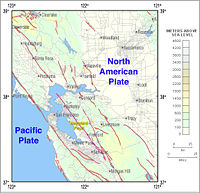
Photo from wikipedia
A few sensing techniques have been developed for detecting defects in civil infrastructures in structural health monitoring (SHM) instead of onsite human inspection. Many false alarms observed are due to… Click to show full abstract
A few sensing techniques have been developed for detecting defects in civil infrastructures in structural health monitoring (SHM) instead of onsite human inspection. Many false alarms observed are due to faults in sensors, and some of them may lead to incorrect interpretation of the measured data. In this paper, the differentiation of different sources of variability, i.e. the sensor fault and structural damage, is investigated for a vibration-based SHM system. A deep learning-based method with a new architecture of Fully connected Stateful Long Short Time Memory (FS-LSTM) Neural Networks for differentiating the sensor fault and structural damage without information on details of the fault is proposed. Information from the sensor fault is assumed local, and that from structural damage is relatively global affecting several sensors. Since the LSTM are capable to learn data features automatically, the proposed method performs well without an accurate mathematical model. Stationary random acceleration responses of a three-span continuous bridge when under operational conditions are studied. A deep network model is applied to the measured data with estimation on four types of sensor fault. The response residues between the true and predicted values of the deep FS-LSTM NN is statistically analyzed to determine the threshold of sensor fault. An experimental study with a steel frame in the laboratory is also performed to validate the proposed method.
Journal Title: IEEE Sensors Journal
Year Published: 2021
Link to full text (if available)
Share on Social Media: Sign Up to like & get
recommendations!